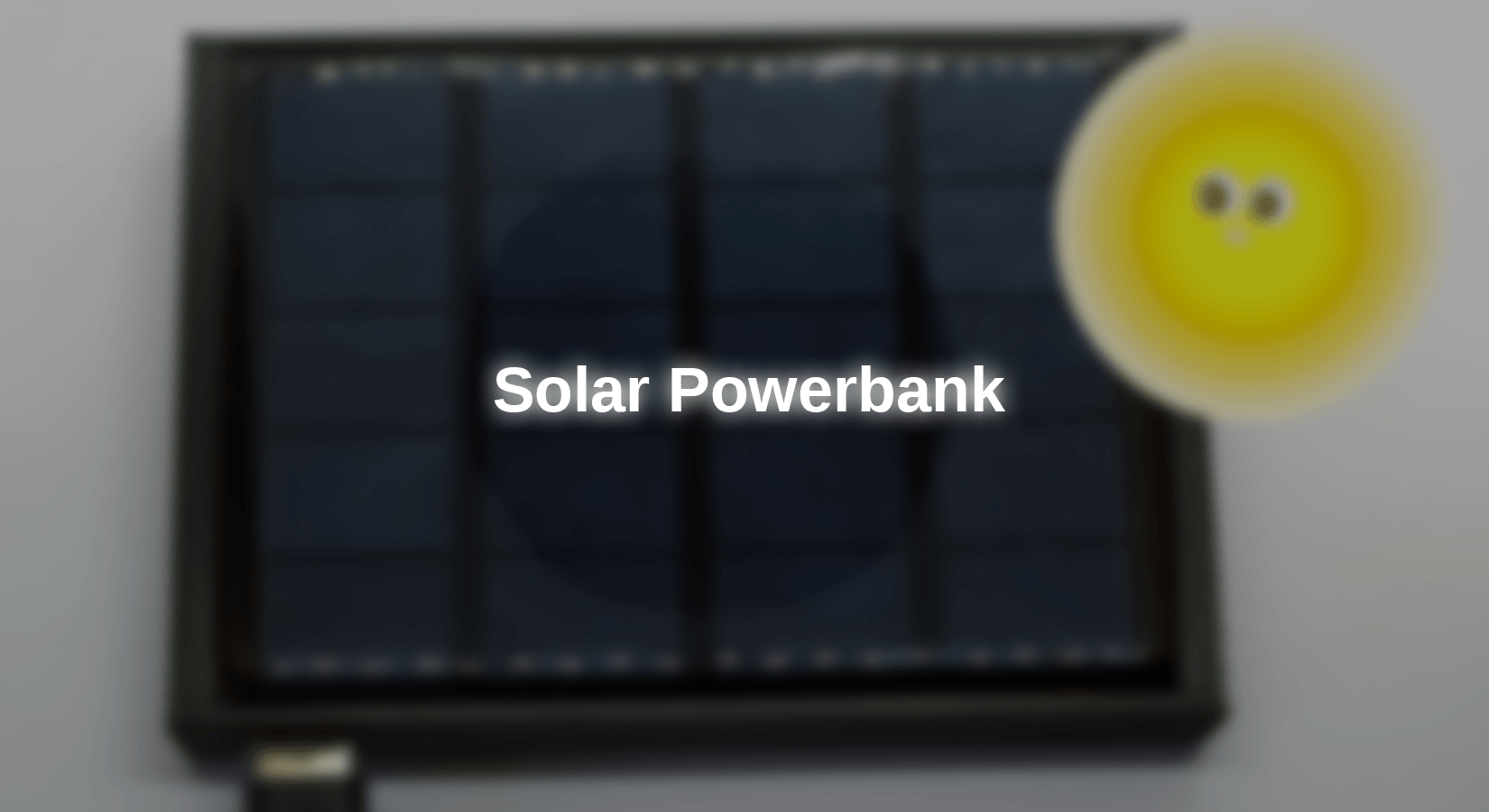Solar Powerbank
A power bank is presented in this article that can be loaded via a solar panel.

Required hardware
| number | Component | annotation |
|---|---|---|
|
1 |
||
|
1 |
|
|
|
1 |
||
|
1 |
|
|
|
1 |
|
|
|
1 |
Cable with connector 1.25mm JSt-PH for battery |
|
|
4 |
Tin screws 2.2 x 13mm |
|
|
1 |
From the 3D printer |
|
|
1 |
From the 3D printer |
Circuit
The solar panel consists of twice 10 solar cells. 10 cells each are switched into a row, so that there is a voltage of approx. 5V. A solar cell works practically like a constant current source, the current of which depends on the incurring solar energy. Depending on the internal resistance of the load, the voltage on the module changes U = i * ri. However, the voltage never gets higher than 5.6V.
A charge controller with the chip TP4056 is used to charge the lithium battery. This charge controller has an input voltage range from 4 to 7V and typical 5V is therefore suitable for the solar panel. A load takes place in low light, but the charging current is then low. The voltage on the battery is up to 4.2V depending on the loading status if the battery is fully charged. The charge controller has two LEDs, a red and a blue one. When a load takes place, i.e. charging current flows, the red LED lights up. If the battery is full, the blue LED shines. If there is no battery, but there is voltage from the solar cell, the blue LED and the red flicker also lights up.

In order for the 5V to be located at the output of the 5V circuit, a step-up converter is required, which places the voltage of the battery from 3.4 to 4.2V to 5V. The entire circuit thus looks like this:
Another note on the performance. With a cloudless sky, a charging current of approx. 150 mA is reached with optimal alignment. With a covered sky 30 to 80 mA.
Danger!
Behind a window pane made of insulating glass, the charging current goes back to a fifth.
Assembly:
First, the individual modules are connected and soldered using the switch wire according to the circuit. Always pay attention to the correct pole. Now infect the battery and set the output voltage to 5V with the potentiometer on the step-up converter.
The two housing parts are made on a 3D printer. One should keep in mind that the power bank will be exposed to the sun for a long time and therefore gets quite warm. PLA is not so well suited because this material becomes soft from approx. 50 to 60 ° C and can deform. PETG is more suitable. The picture shows how the individual modules are accommodated in the housing. Due to the slot at the charge controller you can see the status LEDs from the outside. The solar module is glued into the frame with double -sided adhesive tape.

Of the Blog post by Miguel Torres Gordo to the Solar Tracker Could also be interested in optimizing the yield of the sun's rays.











11 comments
Dominic
Kann man auch mehrere 2000 mAh parallel schalten? Oder funktioniert das mit dem Laderegler nicht?
Gerald Lechner
Der im StepUpConverter verbaute MT3608 hat ein Undervoltage Lockout bei 1.98 V . Da Liion-Akkus nicht unter 2.4 V entladen werden sollen, Sollte man eventuell eine Silizium-Diode in die Plus-Leitung von Batterie zu StepUpConverter schalten. Durch ihre Schwellspannung von 0.7 V erhöht sich der Undervoltag Lockout damit auf ca. 2.7 V
Jan R. Ziebart
Sehe ich richtig, dass wir hier die 2V Eingangsspannung am MD3608 auch als Unterspannungsschutz für den LiPo nutzen? Oder kann /muss ich da was einbauen, damit der nicht zu leer gesaugt wird?
Gerald Lechner
Der verwendete Laderegler ist für LiFePo4 Akkus nich geeignet da seine Ladeespannung zu hoch ist. LiFePo4 hat eine Spannung von 3,6 V während diese für LiPo oder LiIon bei 4,2V liegt. Es sollte ein Laderegler mit dem Baustein TP5000 verwendet werden der für beide Akkuarten verwendet werden kann. Solche Module gibt es ab etwa 5€. Es gibt Module mit grüner Platine, die default auf 3,6V eingestellt sind. Bei der anderen Variante mit roter Platine ist die Defaulteinstellung 4,2V. Hier muss für 3,6V eine Lötbrücke entfernt werden.
Larsu
Ich würde das Ganze gern mit LiFePo4 Akkus bauen, der Laderegler ist dafür aber nicht geeignet,oder? Welcher dann?
Gerald Lechner
Wenn gleiche Module parallel geschaltet werden, die auch gleich von der Sonne bestrahlt werden, sind keine Dioden erforderlich.
Ovidiu Jehac
Hallo,
Braucht man für die Parallelschaltung keine Diode mehr?
Gerald Lechner
Es können auch mehrere Solarmodule parallel geschaltet werden wodurch sich dann der Ladestrom erhöht. Wichtig ist dabei, dass alle Solarmodule dieselbe Nennspannung haben und gleichmäßig von der sonne bestrahlt werden. Selbstverständlich kann auch ein leistungsstärkerer Akku verwendet werden. Er muss aber 3.7V Nennspannung haben und ein Li-Ion Typ sein. Der Laderegler liefert einen maximalen Ladestrom von 1A.
Jippie
Nettes Projekt, aber wie sinnvoll ist es in diesen Dimensionen?
Nach meiner Rechnung dauert es > 11 Stunden bei vollem Sonnenlicht, bis der 2000-mAh-Akku aufgeladen ist. Stimmt das?
So viel Sonne und/oder Zeit hat man meistens nicht, und die 2000 mAh sind auch eher klein dimensioniert.
Daher die Frage: Könnte man auch mehrere Panels (z.B. vier) und einen doppelt so großen Akku verwenden? Dann wäre man vermutlich bei 5,5 h, damit könnte man schon eher arbeiten.
Gerald Lechner
Das sollte kein Problem sein. Damit erreicht man den doppelten Ladestrom. Es sollten allerdings beide Module gleich beleuchtet werden.
Jack
kan men auch 2 Solar Modul 5V parallel schalten?